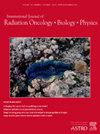临床靶体积利用率对接受立体定向消融放射治疗的非脊柱骨寡转移灶患者疗效的影响
IF 6.4
1区 医学
Q1 ONCOLOGY
International Journal of Radiation Oncology Biology Physics
Pub Date : 2024-10-01
DOI:10.1016/j.ijrobp.2024.07.032
引用次数: 0
摘要
目的/目标尽管立体定向消融放射治疗(SABR)在治疗非脊柱骨转移瘤(NSBMs)方面取得了进展,但围绕靶体积的不确定性依然存在。虽然专家共识指南推荐临床靶体积(CTV),但缺乏失败模式分析,而且较大的治疗体积可能与较高的毒性有关。本研究旨在比较在基于人群的队列中使用与不使用 CTV 治疗 NSBM 的局部失败、边缘失败和毒性。材料/方法对不列颠哥伦比亚省在单臂 II 期 SABR-5 试验(2016 年 11 月至 2020 年 7 月)和不列颠哥伦比亚省寡转移瘤登记(2020 年 8 月至 2022 年 10 月)中使用 SABR 治疗 NSBM 的所有患者进行了回顾性审查。SABR-5和登记处均可选择使用CTV。结果 共纳入 158 例患者(SABR-5 中 113 例,登记处中 45 例)和 200 例 NSBM。159例(80%)NSBM使用CTV治疗,41例(21%)未使用CTV治疗。最常见的组织类型是前列腺癌(60%)、乳腺癌(17%)和肺癌(6%),病变部位接受了 35 Gy 5 次分次治疗(81%)或 24 Gy 2 次分次治疗(14%)。肋骨(34%)和骨盆(47%)是最常见的病变部位。有CTV和无CTV组患者的基线特征和肿瘤特征没有差异。中位随访时间为33.7个月(四分位间距[IQR] = 19.5-48.9)后,局部失败率没有差异,使用CTV治疗的病灶2年局部失败率为9.3%(95%置信区间[CI] = 4.4 - 14.2),未使用CTV的病灶2年局部失败率为7.6%(95%置信区间[CI] = 0 - 15.8)(P = 0.39)。15例(8%)病变出现了边缘失败,边缘失败的定义是疾病复发在GTV以外但在PTV 1厘米以内,2年累积发生率在两组之间没有差异(分别为6.2% [95% CI = 2.3 - 10.1] 和 2.6% [95% CI = 0 - 7.5] [P = 0.16])。总生存期(OS)也相似(2 年 OS = 84.6%,95% CI = 78.1 - 91.1;90.3%,95% CI = 79.9 - 100;P = 0.64)。最常见的≥2级毒性反应是疼痛(18例,9%)和骨折(8例,4%)。没有 4 级或 5 级毒性反应。两组≥2级毒性的2年累积发生率无差异(分别为14.9%,95% CI = 3.9-25.9和15.6%,95% CI = 9.9-21.3;P = 0.78)。由于事件数量较少,对局部和边缘失败事件进行了整理,以进行多变量回归分析。多变量回归结果显示,使用 CTV 与局部边缘失败的风险无关(危险比 [HR] = 2.41,95% CI = 0.81 - 7.18,P = 0.11)。骨外扩展(HR = 2.62,95% CI = 1.07-6.38,P = 0.035)和未接受系统治疗(HR = 3.03,95% CI = 1.40-6.67,P = 0.005)与较高风险相关。结论CTV的使用与局部或边缘失败或毒性无关,骨外扩展和未接受系统治疗与局部边缘失败的风险较高有关。这可能有助于为这一患者群体未来的治疗计划提供参考。本文章由计算机程序翻译,如有差异,请以英文原文为准。
Impact of Clinical Target Volume Utilization on Outcomes in Patients with Non-Spine Bone Oligometastases Treated with Stereotactic Ablative Radiation Therapy
Purpose/Objective(s)
Despite advancements in stereotactic ablative radiotherapy (SABR) for non-spine bone metastases (NSBMs), uncertainty remains surrounding target volumes. While expert consensus guidelines recommend a clinical target volume (CTV), patterns of failure analyses are lacking, and larger treatment volumes may be associated with higher toxicity. This study aims to compare local failure, marginal failure, and toxicity in NSBMs treated with versus without a CTV in a population-based cohort.
Materials/Methods
A retrospective review was conducted on all patients in British Columbia treated with SABR for NSBMs on the single-arm phase II SABR-5 trial (November 2016 – July 2020) and on the BC Oligometastases Registry (August 2020 - October 2022). Use of a CTV was optional for both SABR-5 and the Registry. NSBMs were stratified based on CTV use for treatment planning.
Results
A total of 158 patients (113 on SABR-5 and 45 on Registry) with 200 NSBMs were included. One hundred fifty-nine (80%) NSBMs were treated with a CTV and 41 (21%) without a CTV. The most common histologies were prostate (60%), breast (17%) and lung cancer (6%), and lesions received 35 Gy in 5 fractions (81%) or 24 Gy in 2 fractions (14%). Rib (34%) and pelvis (47%) were the most common lesion sites. Groups with vs without a CTV did not differ in baseline patient or tumor characteristics. After a median follow-up time of 33.7 months (interquartile range [IQR] = 19.5-48.9), local failure rates did not differ, with 2-year local failure 9.3% (95% confidence interval [CI] = 4.4 – 14.2) in lesions treated with a CTV and 7.6% (95% CI = 0 – 15.8) without a CTV (P = 0.39). Marginal failure, defined as disease recurrence outside of the GTV but within 1 cm of the PTV, occurred in 15 (8%) of lesions and 2-year cumulative incidence did not differ between groups (6.2% [95% CI = 2.3 – 10.1] and 2.6%, [95% CI = 0 – 7.5], respectively [P = 0.16]). Overall survival (OS) was also similar (2-year OS = 84.6%, 95% CI = 78.1 – 91.1, and 90.3%, 95% CI = 79.9 – 100, respectively; P = 0.64). The most common grade ≥ 2 toxicities were pain (n = 18, 9%) and fracture (n = 8, 4%). There were no grade 4 or 5 toxicities. The 2-year cumulative incidence of grade ≥ 2 toxicity did not differ between groups (14.9%, 95% CI = 3.9-25.9 and 15.6%, 95% CI = 9.9-21.3, respectively; P = 0.78). Due to low number of events, local and marginal failure events were collated for a multivariable regression analysis. On multivariable regression, use of a CTV was not associated with the risk of local-marginal failure (hazard ratio [HR] = 2.41, 95% CI = 0.81 – 7.18, P = 0.11). Extraosseous extension (HR = 2.62, 95% CI = 1.07-6.38, P = 0.035) and lack of receipt of systemic therapy (HR = 3.03, 95% CI = 1.40-6.67, P = 0.005) were associated with higher risk.
Conclusion
Use of a CTV was not associated with local or marginal failure or toxicity. Extraosseous extension and lack of receipt of systemic therapy were associated with higher risk of local-marginal failure. This may assist in informing future approaches to treatment planning in this patient population.
求助全文
通过发布文献求助,成功后即可免费获取论文全文。
去求助
来源期刊
CiteScore
11.00
自引率
7.10%
发文量
2538
审稿时长
6.6 weeks
期刊介绍:
International Journal of Radiation Oncology • Biology • Physics (IJROBP), known in the field as the Red Journal, publishes original laboratory and clinical investigations related to radiation oncology, radiation biology, medical physics, and both education and health policy as it relates to the field.
This journal has a particular interest in original contributions of the following types: prospective clinical trials, outcomes research, and large database interrogation. In addition, it seeks reports of high-impact innovations in single or combined modality treatment, tumor sensitization, normal tissue protection (including both precision avoidance and pharmacologic means), brachytherapy, particle irradiation, and cancer imaging. Technical advances related to dosimetry and conformal radiation treatment planning are of interest, as are basic science studies investigating tumor physiology and the molecular biology underlying cancer and normal tissue radiation response.

 求助内容:
求助内容: 应助结果提醒方式:
应助结果提醒方式:


